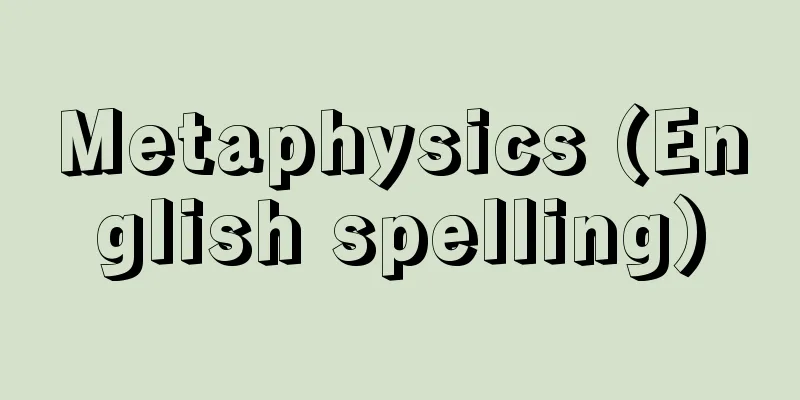Metaphysics (English spelling)

|
A branch of philosophy that critically examines basic philosophical assumptions and seeks to clarify what exists, insofar as it exists. From the Greek words ta meta ta physika, meaning "the book after the book of physics," the translation "metaphysics" was taken from the Xici zhuan of the I Ching. It originated in the Hellenistic period when Andronicus of Rhodes called an untitled work by Aristotle. Metaphysics interacts with other philosophical studies such as logic, epistemology, aesthetics, and ethics, and has traditionally been concerned with a wide range of philosophical problems. The most fundamental problem, first addressed by the ancient Greek philosophers, is the question of the existence and essence of forms, abstract realities that are objects of the mind. Ever since the Greek philosophers distinguished between things in the real world (things we can perceive) and objects of the mind (ideas), metaphysicians have been concerned with the relationship between abstraction and matter, trying to ascertain whether both exist or whether one is more real than the other. Metaphysicians have attempted to explain the natural world, the significance of time and space, and the existence and nature of God, all in an attempt to understand the relationship between forms and ideas. Metaphysical positions are largely a priori positions. A priori starts with basic, mutually consistent hypotheses and develops them to their logical conclusions. If an absurdity arises during this deductive process, the original hypotheses must be discarded or revised. Metaphysical conclusions are, by their very nature, so general and all-encompassing that they are models of thought rather than statements of empirical fact, and so cannot be effectively refuted with counter-evidence. Moreover, unlike empirical science, where new knowledge replaces old beliefs, metaphysics is based on the notion that all the myriad contradictory metaphysical theories stand the test of time and that there is no single metaphysical truth. The first metaphysicians, Parmenides and Plato, recognized the fundamental difference between appearance and substance. Plato rejected the fickle and unreliable reality of the sensible world in favor of a world of ideas that are true because they are unchanging. Starting from Plato's distinction between form and matter, Aristotle integrated the two using a biological model, with matter always moving towards potential ideal forms. In this way, the material world is seen as a continuum of organic change. With the development of Christianity, philosophers became interested in finding an a priori basis for the existence of God. Thomism, based on the metaphysics of Thomas Aquinas, combined Aristotelian thought with Christian thought. According to Thomas, daily meditation (the basis of Aristotle's consideration of the relationship between form and matter) inevitably leads to an understanding of the existence of God, which is the most important factor supporting the material world. By contemplating the finite and ever-changing material world, one is inevitably led to the source of that change, that is, God. Another major shift in metaphysical thought was brought about by R. Descartes. Descartes's dualist philosophy defined the material world and the spiritual world as separate and independent realms. Rejecting the concept of God proposed by Christian philosophers, Descartes assumed that the material world was created by a prime cause, but then operated like a giant machine without any influence from God. I. Kant accepted dualism but did not accept Descartes' theory, and revolutionized metaphysics by showing the importance of perception. According to Kant, material reality must be perceived through the human constructs of time and space. Therefore, our view of the material world is always influenced by the mechanism of perception. Kant thus rejected what earlier metaphysicians considered to be material reality and subordinated all observation to the mechanism of observation. Materialism and idealism attempted to integrate the concepts of spirit and matter in one theory. Idealists merged the two realms by subordinated matter to spirit. Materialists took the opposite position, subordinated mind to matter and asserted that all that exists is matter and that mind is dependent on material conditions. Some philosophers have questioned the methodology and validity of the conclusions of metaphysics. D. Hume argued that all knowledge comes through perception, and concluded that all basic concepts arise from perceptual experience, and that there is no such thing as pure thought. Twentieth-century logical positivism argued that the meaning of all assertions depends on how they are proven, and concluded that metaphysical assertions are meaningless. According to L. Wittgenstein's criticism, metaphysical experience is beyond the scope of language, and some things can only be spoken of and others can only be shown, and metaphysical theorizing fails because it tries to speak about areas outside the scope of what language can reveal. Source: Encyclopaedia Britannica Concise Encyclopedia About Encyclopaedia Britannica Concise Encyclopedia Information |
|
基本的な哲学の仮説を批判的に考察し,存在するものはそれが存在するかぎり何であるかを明らかにしようとする哲学の一分野。「自然学書の次の書」を意味するギリシア語 ta meta ta physikaに由来し,形而上学という訳語は,『易経』繋辞伝からとられた。ヘレニズム期にアリストテレスの表題なしの著作を,ロドスのアンドロニコスがそのように呼んだのに始る。形而上学は論理学,認識論,美学,倫理学などの他の哲学的研究とも影響し合い,伝統的に幅広い哲学的な問題に関連してきた。最も基本的な問題は古代ギリシアの哲学者たちが最初に取組んだもので,形相の存在と本質,すなわち心の対象である抽象的な現実という問題である。ギリシア哲学者たちが現実の世界のもの (知覚できるもの) と心の対象 (観念) を区別して以来,形而上学者たちは抽象と物質の関係にたずさわり,両方が存在するのか,あるいはどちらか一方がもう一方より確かに存在するのかを確かめようとした。形而上学者は,自然界,時間と空間の重要性,神の存在と本質を解明しようとしたが,すべて形相と観念の関係を理解しようとする試みだった。 形而上学の主張はおおむね先験的な立場である。先験主義は,基本的で相互に矛盾のない仮説から出発し,それらを論理的な結論まで発展させる。この演繹的なプロセスの間に不合理が起れば,元の仮説を捨てるか,見直さなければならない。形而上学の結論は,その性質上あまりにも一般的でありとあらゆるものを含む主張なので,経験的事実を述べたものというよりは考え方の模範を示したものであり,それを反証を使って論駁するのは効果的な批判とはいえない。そのうえ,新しい知識が古い信念に取って代る経験科学とは異なり,矛盾する無数の形而上学的な理論はすべて時間の試練に耐えており,唯一の形而上学的な真理は存在しないという概念に立脚している。最初の形而上学者であるパルメニデスとプラトンは,外観と実体の基本的な違いを認めた。プラトンは,変ることがないゆえに真実である観念の世界を支持して,知覚できる世界における移ろいやすくあてにならない現実を否定した。アリストテレスはプラトンの形相と質料の区別から始めて,生物学モデルを用いてこの2つを統合し,質料は常に潜在的な理想形相に向って動いている,と考えた。このようにして,物質世界は有機的な変化の連続体とみなされる。キリスト教の発展に伴って,哲学者たちは神の実在の先験的論拠を発見することに関心をいだきはじめた。トマス・アクィナスの形而上学に基づくトミズムは,アリストテレスの思想とキリスト教思想を結びつけた。トマスによると,日々の黙想 (アリストテレスによる形相と質料の関係の考察の基礎) は必然的に神の実在の理解につながり,物質世界を支える最も重要な要因である。有限で変転きわまりない物質世界を考察することによって,人はその変化の原因,つまり神に必ず導かれる。 形而上学の思想にもう一つの大きな転換をもたらしたのは,R.デカルトである。デカルトの二元論の哲学は,物質世界と精神世界を別個の独立した領域と定義した。キリスト教哲学者が提唱した神の概念を否定して,物質世界は主因によってつくられるが,その後は巨大な機械のように神の影響とはかかわりなく動く,とデカルトは仮定した。 I.カントは二元論は認めたがデカルトの理論は受入れず,知覚の重要性を示して形而上学に革命を起した。カントによると,物質的現実は時間と空間という人間のつくった構成概念を通じて知覚しなければならない。したがって,物質世界に対する見方は常に知覚のメカニズムによって影響を受ける。カントは初期の形而上学者が物質的現実と考えたものをそのように否定し,すべての観察を観察のメカニズムに従属させた。唯物論と観念論は,精神と物質の概念を一つの理論のなかで統合しようと試みた。観念論者は,物質を精神に従属させることによって2つの領域を合流させた。唯物論者は正反対の立場をとり,精神を物質に従属させて,存在するのはすべて物質で精神は物質的な状況に依存すると主張した。 哲学者の一部は,形而上学の方法論と結論の有効性を問題にした。 D.ヒュームはあらゆる知識は知覚を通じて入ってくると主張し,すべての基本概念は知覚の経験から生れるのであって,純粋な思惟など存在しない,と結論づけた。 20世紀の論理実証主義は,すべての主張の意味はそれがどのように証明されるかに依存していると主張し,形而上学的主張には意味がないとの結論を下した。 L.ウィトゲンシュタインの批判によると,形而上学的経験は言語の範囲をこえたもので,物事には語ることのできることと,見せることしかできないことがあり,形而上学的な理論化は言語が明らかにできる範囲外の領域について語ろうとしているためにうまくいかないとしている。 出典 ブリタニカ国際大百科事典 小項目事典ブリタニカ国際大百科事典 小項目事典について 情報 |
>>: Metaphysical painting - pittura metafisica
Recommend
Gyōshin
Years of birth: unknown. A monk from the Nara peri...
Baal
An ancient Syrian-Palestinian god. Meaning "L...
Nieuw-Amsterdam (English spelling)
…The company was divided into five branches (Kame...
"Daughter of Orokko" - Orokko's daughter
…Born in Daishoji, Ishikawa Prefecture. While stu...
Job introduction - Job introduction
Both companies looking to hire employees and peop...
Spawning - Sanran
When an animal lays eggs, fertilized eggs are exp...
The Great Fear (English: Grande Peur, French)
This refers to the social unrest that began in Ju...
Fly Trap - Flytrap
A device that lures flies inside and prevents them...
Azumiyamasehirafu - Azumiyamasehirafu
...Years of birth and death unknown. Also called ...
New Devotion - Atarashiki Shinjin
...the movement and underlying ideas that attempt...
Nummulites
A group of macroforaminifera (higher foraminifera...
Makonde
…Linguistically, they belong to the Central Bantu...
Perioikoi - Greek word perioikoi
Meaning "people living in the outskirts,&quo...
《Vampire Bani》
...The vampires of Merimee and Gogol remained in ...
Ozu Castle Town
…The site of the residence of Toju Nakae, a leadi...




![Ubangi [river] - Ubangi](/upload/images/67caff5d9d20a.webp)




